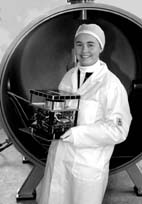Swedish Institute of Space Physics
(IRF)
Kiruna, Sweden
15 March 2001
PRESS RELEASE
DOCTORAL DEFENCE AT SWEDISH INSTITUTE OF SPACE
PHYSICS, KIRUNA,
23 March 2001

On Friday the 23rd of March 2001 Solveig Helene Høymork, Swedish Institute of Space Physics in Kiruna and Department of Space Physics, Umeå University, will defend her doctoral thesis entitled:
"Lower Hybrid Cavities and Other Plasma Phenomena in the Subauroral Region".
The defence takes place at 10 a.m. in the Auditorium at the Swedish Institute of Space Physics, Kiruna.
Faculty opponent: Dr. James Labelle, Dartmouth College, Hanover, N.H., USA.
Solveig Høymork completed her undergraduate studies at the University of Oslo in the spring of 1997. Since January 1998 she has been a doctoral student at the Swedish Institute of Space Physics in Kiruna.
This thesis analyses data from two Swedish satellites, Freja and Astrid-2. These satellites orbited the earth over the poles and took measurements in the auroral zone at heights of 1700 km and 1000 km respectively. This is the upper ionosphere where a large proportion of the atoms are ionized, creating a plasma. The study is restricted to the subauroral region. This area is expected to be less dynamic than the area in which aurora is usually visible. Nevertheless exciting phenomena occur there as well. Data shows localized thinning in plasma density, known as cavities. Both small-scale (ca 50 m) and large-scale (ca 1000 km) cavities have been observed. There are many physical processes that can lower the local density of plasma and thus create cavities, for example wave-particle interaction, electric fields and plasma transport. The thesis deals with several different types of cavities and localized higher density ion clouds, and gives possible explanations as to why these occur.
Both Freja and Astrid-2 were relatively cheap satellites. They have supplied a wealth of very interesting data and contributed to an increased understanding of our universe and some of the processes which affect its environment. It is becoming increasingly important to understand the environment in space , as more and more human activity takes place there (for example commercial satellites and space travel).
More information:
Rick McGregor, Information Officer, Swedish Institute of Space Physics, tel. +46-980-79178, rick.mcgregor@irf.se
Solveig H. Høymork, Swedish Institute of Space Physics, tel: +46-980-791 79,solveig.hoymork@irf.se
Web site: http://www.irf.se
Pictures: http://www.irf.se/~solveig/presse/
The Swedish Institute of Space Physics (in Swedish: Institutet för rymdfysik, IRF) is a governmental research institute. Its primary task is to carry out basic research, education, and associated observatory activities in space physics and atmospheric physics.
|
Postal address |
Telephone |
Fax number |
E-mail address |
|
Box 812 |
0980-790 00 |
0980-790 91 |
|
|
SE-981 28 Kiruna |
Int. +46-980-79000 |
Int. +46-980-79091 |
Internet |
|
SWEDEN |
|
|
